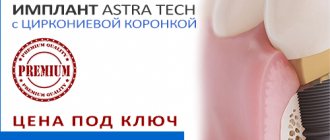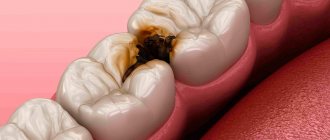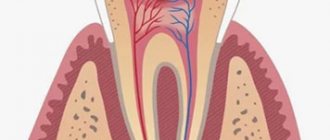Author of the article:
Soldatova Lyudmila Nikolaevna
Candidate of Medical Sciences, Professor of the Department of Clinical Dentistry of the St. Petersburg Medical and Social Institute, Chief Physician of the Alfa-Dent Dental Clinic, St. Petersburg
Weak and loose gums are a problem that many people face today. As a rule, the appearance of this defect is preceded by inflammatory periodontal diseases, such as gingivitis and periodontitis. Patients with such diseases suffer from a number of unpleasant symptoms:
- Severe redness, swelling of the gums;
- Bleeding while eating or brushing teeth;
- Tooth mobility;
- The formation of “pockets” - spaces between the tooth and gum, in which food debris, bacterial mass, and, in some cases, pus accumulate;
- Exposure of the cervical area of the teeth, and in severe cases, the roots.
- Strong, pungent odor from the mouth.
The listed symptoms are only the most harmless consequence of weakening gum tissue. In the absence of proper treatment, it threatens the loss of teeth, including healthy ones. That is why strengthening the gums and teeth is the primary task of the dentist and periodontist when treating patients with such problems. However, today it is also possible to strengthen gums at home. You will learn how to strengthen your gums and teeth yourself from our material.
Causes associated with dental diseases
The cause of loose teeth in the gums can be various dental diseases, such as periodontitis, periodontal disease, periodontitis and gingivitis. Incorrect bite can also trigger the appearance of this disease.
With gingivitis, many bacteria live in the oral cavity, which cause bleeding gums and, as a result, loosening of teeth.
With periodontitis, the same symptoms are present, but they are also accompanied by bad breath and inflammatory processes in the gums begin. The cause of both diseases is poor oral hygiene.
Periodontal disease is not associated with inflammatory processes and is accompanied by a decrease in the bone walls between all teeth, resulting in bleeding and itching in the gums, and the teeth become mobile and their sensitivity increases.
For what reasons can a tooth root become inflamed?
Despite the availability of many effective methods of therapeutic treatment of inflammation under the tooth root, it is often necessary to resort to the use of surgical treatment methods. This is indicated in the following cases:
- Root canal obstruction was detected
- there is a pin or stump tab that cannot be removed without damaging the root
- there are many cysts - perihilar or growing into the maxillary sinus
- there is a perforation (perforation) of the wall of the tooth root or its cavity
- The use of conservative methods of treating root inflammation does not help
Important:
Most often, periodontitis refers to inflammation in the area of the apex of the tooth root (apical, periapical periodontitis). The cause of tooth root inflammation is untimely treatment of caries and pulpitis. Another type of disease, marginal periodontitis, is classified as periodontology; in this case, the lesion spreads to the gums in the cervical part of the tooth.
Causes of disease not related to gum disease
Dental disease is not the only factor that causes loose teeth. This process can occur for a number of other reasons:
- As a result of genetic predisposition to the disease.
- Weakening of the immune system.
- Diabetes.
- Hormonal imbalances.
- Psoriasis.
- Trauma to the maxillofacial area.
- Arthritis.
Only a dentist can correctly determine the cause of the disease. If the teeth are loosened as a result of a strong blow, the doctor sends the patient for an x-ray for a more detailed diagnosis, and then decides on subsequent treatment. If the cause is a chronic disease, the doctor will prescribe dental procedures or prescribe the appropriate medication to strengthen the gums.
Other diseases that give similar symptoms
It was already said above that 90% of patient requests fall into one of the three cases already described. But there remains another 10% of calls with the complaint that “the gums are swollen.” Edema or conditions similar to them in appearance can cause precancerous diseases, hormonal changes, cancer itself, HIV infection, diabetes and many other diseases. And with everyone there will be swelling, perhaps there will be pain. Therefore, it is very important if you detect any swelling, growths, or bulges on the gums to consult a doctor to find out the cause of this phenomenon and timely treatment.
Diet and vitamins
Proper, balanced nutrition is necessary for gum health. To strengthen the mucous membranes and blood vessels, you need to eat foods high in vitamin C, such as citrus fruits and green leafy vegetables. Vitamin K, found in large quantities in green vegetables and herbs, has a similar effect. Antioxidants and tannins contained in green tea and red wine have an anti-inflammatory and healing effect, slowing down the aging process. In addition, it is important to consume enough phosphorus, calcium and zinc - they are contained in seafood, garlic and onions, and dairy products.
Vitamin complexes are well suited as an additional source of nutrients - in particular, the vitamin-mineral complex for teeth ASEPTA. It contains vitamins A, B3 and B6, C, D3, as well as coral calcium and green tea extract. In addition, coenzyme Q10, which is contained in the complex, has a powerful regenerating effect and restores damaged gum tissue.
Folk remedies for treating illness
Regular rinsing of the mouth with special solutions or decoctions of medicinal plants is an excellent remedy for strengthening the gums. For this purpose, you can use decoctions of oak bark, eggplant peel, and horseradish. The most popular herbs for strengthening gums are chamomile, sage, St. John's wort, mint, and burdock.
Four folk recipes for rinsing to strengthen gums:
- Tea tree oil is an effective remedy for strengthening weak gums due to its ability to heal wounds and fight bacteria. To prepare a solution that needs to be used to rinse the mouth, take 2 drops of oil and half a glass of clean water.
- One of the popular folk recipes is a tincture made from a mixture of linden blossom and oak bark in equal proportions. To prepare it, just take a teaspoon of each component and pour 2 cups of boiling water over them. You should rinse your mouth with the resulting product after each meal.
- You can disinfect the oral cavity with cognac. To do this, you need to rinse it with a small amount of drink.
- Burdock decoction. The product should be used at least twice a day. To prepare it, you need to boil a tablespoon of the herb in 500 milliliters of water, then cool and strain through cheesecloth or a sieve.
To strengthen the gums and teeth, it is recommended to massage with the thumb and forefinger. The gums are treated with vertical massaging movements - from one tooth to another. Each section should be worked for 20 seconds. To increase efficiency, you can carry out the procedure by first dipping your fingers in honey or tea tree oil.
To strengthen the gums, it is recommended to use lotions:
- Plantain juice helps a lot. A cotton or gauze swab is moistened in it and applied to the gum.
- A decoction of young pine needles. To prepare the lotion, you need to boil 3 tablespoons of needles in 200 milliliters of water for 10 minutes. After this, the product is infused for at least 7 hours. A cotton swab dipped in the broth is applied to the sore gums.
Bases of inflammation
Sore gums: what to rinse with? This is one of the popular questions that patients ask themselves when they come to see the dentist. An experienced specialist knows that the chosen treatment method will depend on the reasons for the manifestation of signs of the disease, that is, the current symptoms. The main reason for the neglect of the normal condition of the gums is considered to be improper and infrequent oral care:
- rare brushing of teeth;
- superficial cleansing of teeth, when hard-to-reach places remain untouched;
- a toothbrush is not suitable for cleaning;
- no rinsing after a light snack.
As a result of these factors, food remains between the teeth, which creates a favorable environment for the growth of bacteria. Pathogenic microflora further contributes to the formation of plaque. If it is not removed, a stone begins to form, which, with its sharp edges, can damage the gums and cause inflammation.
The most common remedy for treating inflammation is a special solution. A family dentist can answer the question of what to rinse your mouth with when you have gum inflammation. Experts also recommend paying attention that factors such as thyroid disease, weak immunity, increased tissue sensitivity, heredity, bad habits, concomitant oral diseases, and lack of vitamins B, D, C can accelerate or provoke the development of the disease.
Ointments and gels
The main advantage of gels and ointments compared to rinses is their ability to remain longer on the surface of the gum mucosa - and, as a result, provide a therapeutic effect for a longer time. ASEPTA healing gel contains propolis, a component of natural origin that has antibacterial, anti-inflammatory and regenerating effects. Thanks to this, the gel, when used regularly, can eliminate almost all the unpleasant symptoms that accompany weakening gums, as well as have a positive effect on the condition of the tissues themselves. The product is applied twice a day to the affected areas (necessarily after thorough brushing of the teeth). After using it, do not consume food or liquid for half an hour. This gel allows you to quickly strengthen your gums at home.
An equally effective remedy is the adhesive balm ASEPTA. The sticky pectin base prevents saliva from washing off the balm from the surface of the mucous membrane - its antimicrobial effect lasts more than half an hour. The balm contains powerful antiseptic components - chlorhexidine and metronidazole, which can prevent the development of inflammatory gum diseases - gingivitis and periodontitis.
Sores in the mouth as a sign of aphthous stomatitis
Wounds in the mouth can arise as a result of the development in a person of a separate independent disease of the oral mucosa, caused by the growth and development of pathogenic microorganisms. But, in addition, the cause of such wounds may also be hidden in the general somatic condition of an adult or child.
In most cases, mouth ulcers are symptoms of a disease such as canker sores. Stomatitis is a lesion of the human oral mucosa that occurs as a result of an atypical reaction of the immune system to foreign irritants. Depending on the nature and causes of the disease, stomatitis can be of various types: ulcerative, herpetic, allergic, vesicular, etc. But people most often have to deal with the aphthous form of this disease.
Let's name the main symptoms of aphthous stomatitis:
- The appearance of round ulcers (ulcers) in a person’s mouth, which are grayish in color and surrounded by a red, inflamed rim. Ulcers are located either separately or in groups and have different sizes.
- Painful sensations in the affected areas of the upper and lower palate of a person that occur during eating, drinking, or talking.
- Deterioration of a person’s general well-being, weakness.
- Temperature increase. But this is not a mandatory symptom; it occurs in most cases in children, since they are more difficult to tolerate aphthous stomatitis in the oral cavity.
- Enlarged submandibular lymph nodes. This symptom of aphthous stomatitis also occurs more often in children than in adults.
Toothpaste for strengthening gums
Therapeutic and prophylactic toothpastes are also an excellent tool for combating looseness of gingival tissue. Proper brushing of teeth is effective in itself - by massaging the gums with a brush, we improve blood circulation in the tissues and remove plaque, which is a constant source of infectious danger. In addition, many pastes contain antiseptic components that kill pathogens. However, it should be remembered that such pastes cannot be used for a long time, as this may negatively affect the state of the natural microflora of the teeth.
For regular use, pastes based on natural ingredients are better suited. For example, ASEPTA and ASEPTA Sensitive toothpastes contain extracts of calendula, sage, St. John's wort, sweet clover, calamus and other medicinal plants that relieve inflammation, eliminate bleeding and have a mild antiseptic effect. ASEPTA Sensitive paste also contains minerals - potassium citrate and hydroxyapatite, which increase the resistance of teeth to caries.
How to strengthen teeth and gums? Basic recommendations
List of recommendations for strengthening gums:
- Use special toothpastes.
- Introduce dairy products into your diet, as well as foods containing large amounts of vitamin D.
- Use rinse aids.
- Use floss to clean teeth in hard-to-reach areas.
- See your dentist regularly to check the condition of your teeth and gums.
See your dentist regularly to check the condition of your teeth and gums.
Consumer Reviews
Kotty about Asepta adhesive gum balm (otzovik.com)
“I had to purchase this adhesive balm because the dentist diagnosed me with periodontal disease. Therefore, when I have gum inflammation, I use this drug in courses every 6 months. I must note that the drug very quickly exerts its healing effect on the gums. The pain goes away immediately after starting treatment.
The dentist recommended that I lubricate my gums at night, once a day for 7 days.
Having studied the composition, I saw there such a substance as metronidazole and chlorhexidine. I realized that metronidazole is still an antibiotic. But since I was prescribed this medicine, I was calm. Although, frequent use of substances such as chlorhexidine and metronidazole on the skin and mucous membranes is undesirable, because the protective properties that the mucous membrane and skin should produce may cease to be produced. The dentist told me this too. Therefore, it is very important to use such products only for their intended purpose and strictly according to the instructions.
Of the indicated effects of the balm on the gums, the following were indicated:
- pronounced antibacterial effect on the gums;
- relieving inflammation and bleeding gums;
- breath freshening.
The package also contained a special plastic spatula, which was used to apply the balm to the gums. I must say that it is very comfortable. The balm itself is very thick and hardens after application. But the taste is generally tolerable.
I am satisfied with the effect of the balm. Good quality. It's not that expensive, considering that it lasts a long time. I recommend".
Minuto4ka about Asepta mouthwash (otzovik.com)
“Mint is an acquired taste, in everything. For example, I can completely tolerate it and love it. But I know a lot of people who can’t stand tongue-biting additives.
These are the first associations that arose for me when I first used this mouthwash.
It is sweet and has a lime flavor. And absolutely non-biting.
They prescribed it to me for absolutely no reason, of course.
My dentist prescribed it for me. For gums, which really bother me due to the periodic eruption of wisdom teeth. Which I'm terrified of deleting.
The rinse aid is sold in pharmacies, I haven’t seen it in supermarkets, which captivates me. I would like to believe that it is truly therapeutic in nature. They prescribed me this mouthwash along with Asepta dental gel. I don’t know which of them helped in the end. Maybe all together.
I think the advantage of the bottle is the presence of a measuring cup. It is very comfortable. Not all mouthwashes have it...
... overall I recommend it. At least it will win over its audience with its taste.”
Sources:
- Study of the clinical effectiveness of the use of therapeutic and prophylactic agents of the ASEPTA series in the treatment of inflammatory periodontal diseases in children and adolescents (I.V. Klimova) Irina Vladimirovna Klimova, Candidate of Medical Sciences, Associate Professor of the Department of Pediatric Dentistry, Novosibirsk State Medical University. Department of Pediatric Dentistry, Novosibirsk State Medical University.
- Clinical studies of antisensitive toothpaste “Asepta Sensitive” (A.A. Leontyev, O.V. Kalinina, S.B. Ulitovsky) A.A. LEONTIEV, dentist O.V. KALININA, dentist S.B. ULITOVSKY, Doctor of Medical Sciences, Prof. Department of Therapeutic Dentistry, St. Petersburg State Medical University named after. acad. I.P. Pavlova
- Report on clinical trials to determine/confirm the preventive properties of commercially produced personal oral hygiene products: mouth rinse "ASEPTA PARODONTAL" - Solution for irrigator." Doctor of Medical Sciences Professor, Honored Doctor of the Russian Federation, Head. Department of Preventive Dentistry S.B. Ulitovsky, doctor-researcher A.A. Leontiev First St. Petersburg State Medical University named after academician I.P. Pavlova, Department of Preventive Dentistry.
- The role of anti-inflammatory rinse in the treatment of periodontal diseases (L.Yu. Orekhova, A.A. Leontyev, S.B. Ulitovsky) L.Yu. OREKHOVA, Doctor of Medical Sciences, Prof., Head of Department; A.A. LEONTIEV, dentist; S.B. ULITOVSKY, Doctor of Medical Sciences, Prof. Department of Therapeutic Dentistry of St. Petersburg State Medical University named after. acad. I. P. Pavlova
Experts' opinion
Numerous clinical studies have proven the therapeutic effect of the Asepta line of drugs.
All focus group patients noted the analgesic effect of the product; after using the rinses, tissue healing was observed in all patients; the hygienic condition of the oral cavity improved in all patients. The products are recommended in the complex treatment of patients, and their availability and ease of use make it possible to recommend them in the clinical practice of dentists[1]. According to the results of clinical studies, after 3 weeks of using ASEPTA® rinse, gum bleeding decreases by 28.3%, inflammation decreases by 32.3% and oral hygiene improves by 33.5%*.











